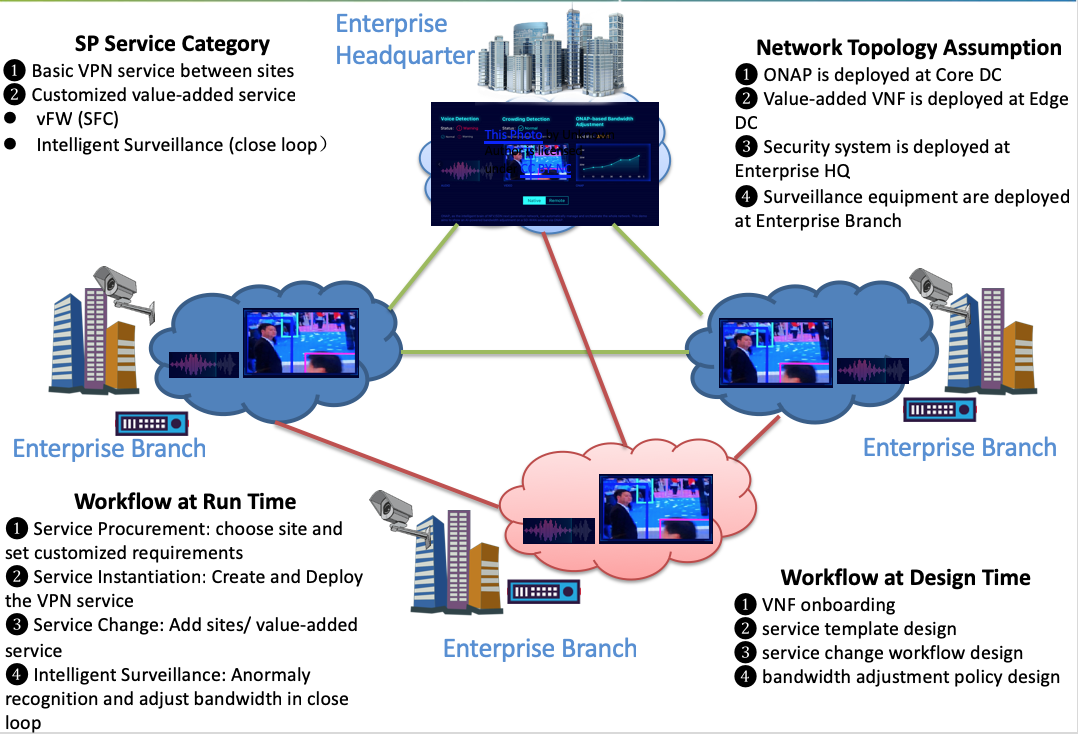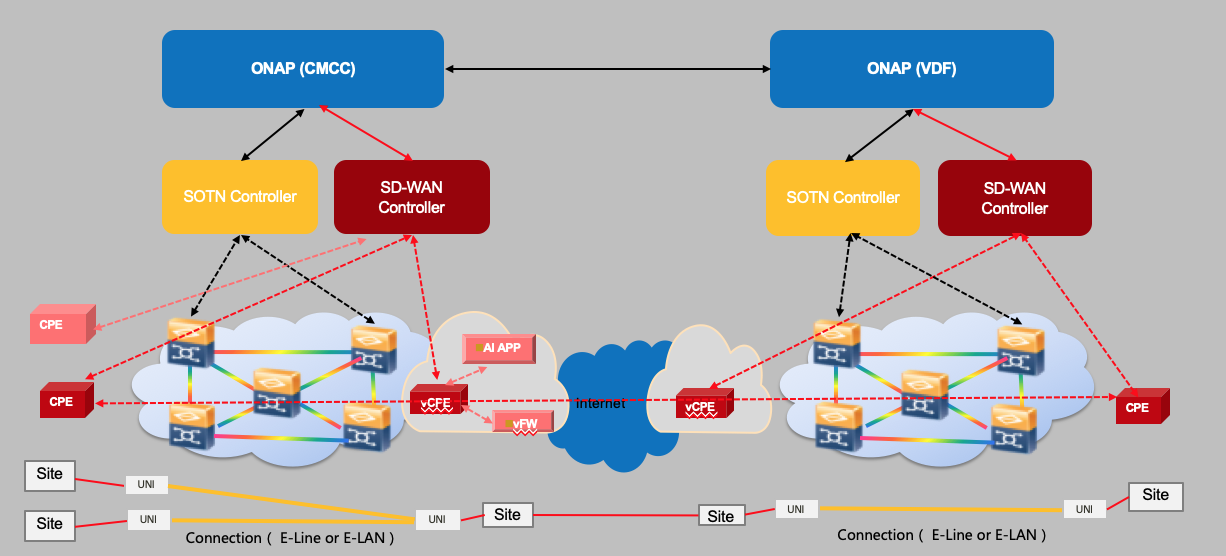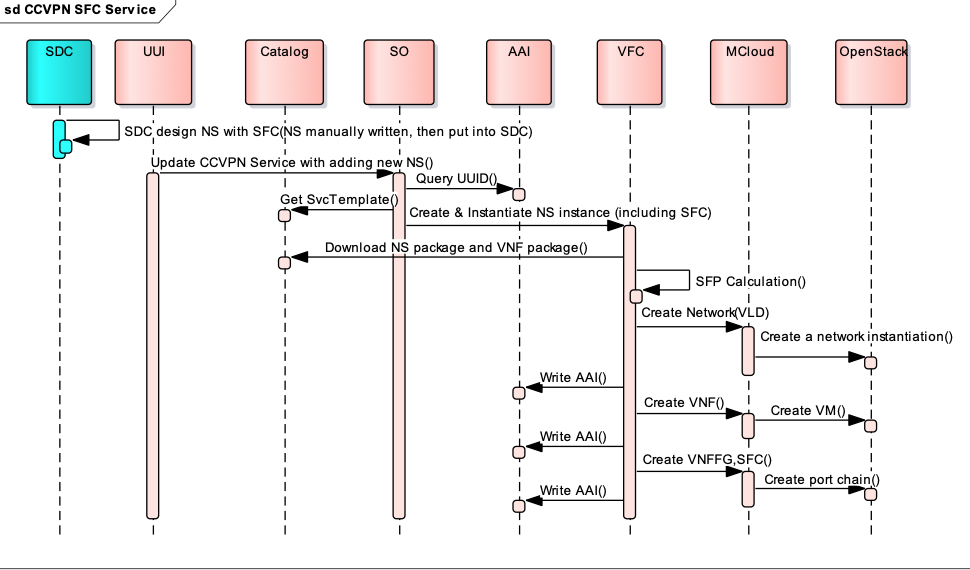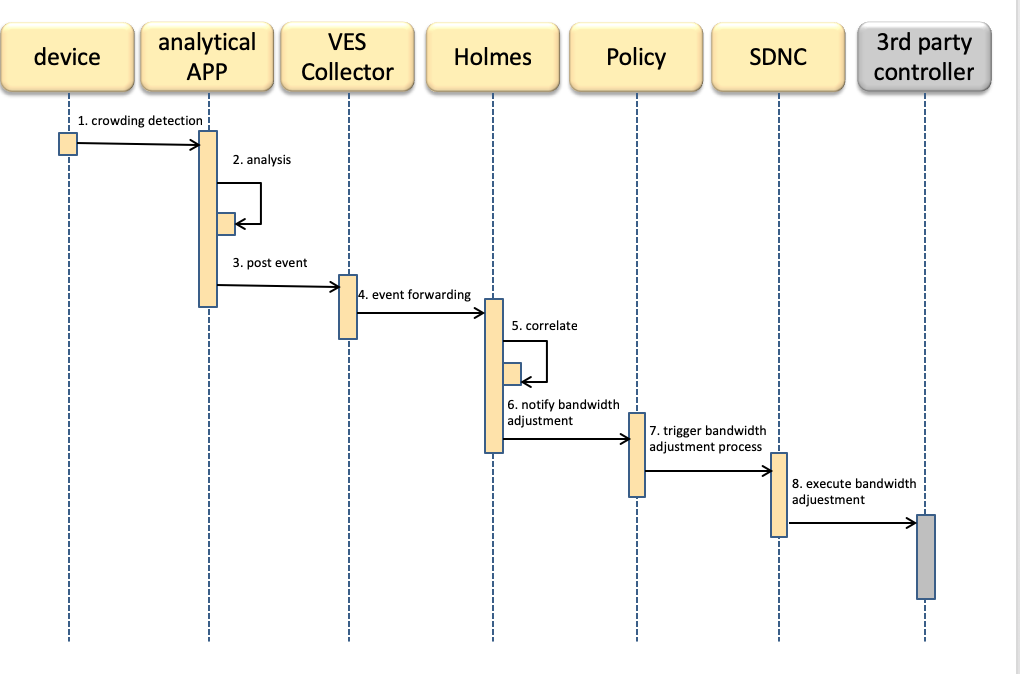Use Case Authors:
China Mobile, Vodafone, Huawei, ZTE, VMWare, Intel, WindRiver, China Telecom, Fujitsu, Lenovo
NOTE: More participants are welcome.
Overview
Recap for Casablanca
In Casablanca release, we propose CCVPN(Cross Domain and Cross Layer VPN) use case, in which scenario if a customer wants to set up a VPN from Beijing to London, we can use ONAP to stretch such a VPN service that is cross operator, cross domain and cross layer.
cross operator: the VPN service could be stretched between two ONAPs.
cross domain: a VPN service is cross diffrent OTN domains which is controlled by different 3rd parties
cross layer: the VPN service can be l1,l2,l3 or any composition of these layers, eg: a VPN service that is cross l2 and l3
From an Operator's perspective, it is important to introduce the capability to manage the performance of the CCVPN End-to-End service (especially when it spans across different Operators). The ultimate goal of this use case is, by taking advantage of the strong orchestration ability of ONAP, to automatically create and deploy a cross operator, cross domain (SOTN + SD-WAN), cross layer (L1, L2, L3) end to end VPN and update the service dynamically.
Main functions in this use case include automatically design of end to end service, creation of end to end service, cross-domain resource cooperation, global rerouting.
We testified this possibility in C release and realized functions like topology discovery, simple service creation, as well as back-up link switch in closed loop.
Planning for Dublin (Not fully provided in Dublin Release, will be continued in Frankfurt Release)
In Casablanca, the basic CCVPN usecase demonstrated ONAP's capability in designing and creating an end-to-end VPN service across operator domains.
In realistic CCVPN service deployment, the customer may want to add two sites in Shanghai and Wuhan onto the original service due to their business needs. Customers also have the need to do some modifications on the existing service, eg: to change the bandwidth or to build up a vFW in the VPN.
Therefore, in Dublin release, we would like to extend the scenario of CCVPN use case to include enhancements in the following aspects:
- Service Change Management, to allow the customer to dynamically add more branch sites or value-added services (e.g. vFW) on demand to individual site onto their running CCVPN service instances.
- Intelligent Bandwidth on Demand, to allow third party analytics applications to trigger ONAP close loop for adjusting the running CCVPN service instances (e.g. the bandwidth between specified sites).
User Stories
Service Provisioning Categories
In Dublin, CCVPN assumes the SP provides two types of service functions to its enterprise customer for selection, including:
- Basic VPN service between sites, where the number of sites and the bandwidth among them could be adjusted dynamically.
- Value-Added services which could be part of the intial service procurement before its creation or added on demand to a running service instance.
To best represent the common requirements for potentially huge number of value-added services that might be interesting to the cutomer, two are selected for CCVPN demonstration, including
- vFW, which demonstrate the requirements for chaining another traffic handling function into the user plane, and
- intelligent surveillance application, which demonstrate the requirement for distributed deployment architecture in the user plane and also the close loop automation integration in the control plane.
Network Topology Assumptions
A network hierachy of at least two layering of DCs are assumed in this usecase, including:
- the core DC, where the ONAP central is running, and
- the edge DCs, where the virtual functions/applications that are deployed near the customer's sites are running.
For the intelligent surveillance application, which is a specific value-added service, once initialized,
- its centralized monitoring portal is deployed at the edge DC near the enterprise HQ, and
- the AI applications for collecting both the vioce/video monitoring and anormaly recognition, are deployed in a distributed fashion to the edge DCs that are near the specific site(s) under surveillance.
User Stories
Two kinds of people are assumed in this case:
1) Customer: Owner of a service, people who want to place a CCVPN service order, change the order and pay money for the service. They have less or no knowledge of technology details.
2)User: Executor of instantiating, monitoring and managing a CCVPN service. Detailed CCVPN service parameters are provided by these people who are experts in how to run a CCVPN service and know all the detailed inputs well.
Service Procurement (SP)
The enterprise HQ may want to order a VPN stretch between two or more branch sites, they may also want other value added services bind with the VPN service. A customer facing portal is provided under this condition so that a customer can choose which sites to set the VPN service and combine what kind of value added service with the VPN service, as well as provide other customized needs of the service like the bindwidth and duration without knowing the deployment details and VPN parameters. We call this process as service procurement and a service order is placed at this phase.Service Instantiation (SI)
After the service order is obtained, another page will pop out for users to finish other detailed inputs of CCVPN parameters so that a CCVPN service can be instantiated and deployed by ONAP.Service Change (SC)
Besides setting up a VPN service between multiple sites, customer may also have the needs to add other sites or add a new value-aadded service onto the existing VPN service according to their demands.SC1: Adding a new site
Customer chooses "Change Service" button in customer portal, and selects the sites to be added. After the order change is finished, the changed order will be passed to user portal to inform the user. Then, users will modify the sites information as well as other service input parameters and command ONAP to do the service change.SC2: Adding a new value-added service
Customer chooses "Change Service" button in customer portal, and selects the value-added service to be added. After the order change is finished, the changed order will be passed to user portal to inform the user. Then, user will add related parameters and command ONAP to do the service change.
Close Loop Intelligent Suveillance (IS)
After user subscribes the AI apps, AI apps on the edge can analysis data collected by camera or other security detector. Once there is an alarm, the original alarm data will be transferred to Ves Collector and DMaaP will translate the data, Holmes will send the event to Policy to trigger the responding action to adjust the bandwidth in close loop.
Gap Anaysis and Functional Requirements
Implementation Proposals
Design Time Workflows
VNF onboarding
Service Template Design
Service Change Workflow Design
Bandwidth on Demand Policy Design
Run Time Sequence Diagram
Service Procurement (SP)
Service Instantiation (SI)
Service Change (SC)
SC1: Adding a new site
SC2: Adding a new value-added service
Close loop Intelligent Suveillance (IS)
Current Situation
In Casablanca release, the CCVPN service is created by mean of separate multiple Service Orders via TMF 641, with one service orderItem for each of the services that make up the CCVPN connectivity Service. (Note -the UUI in Casablanca makes separate calls to SO, i.e. does decomposition but without Service Orders)
The complete removal of the CCVPN Service would involve the Portal/UUI making multiple separate Service Orders with one orderItem, each with a ‘delete’ action. This because there is no E2E Service Instance that corresponds to the full CCVPN Service.
High Priority Extensions (enhancements) in Dublin release:
Multi-site to multi-site Service Creation
In an ideal implementation, the Portal shall create a single Service Order via TMF 641, with multiple service orderItem(s) for each of the services that make up the CCVPN Service.
- SDC should support create an E2E service with one service template by supporting inputs of multiple resources at the same time (instead of using multiple service templates one by one when creating an E2E service) and SO should have the capability to decompose and (eventually) delegate the nested Services.
- A&AI should maintain composite End-to-End Service Instance for CCVPN.
- Parameters for all services can be passed as one composite orderItem to External API.
Service Change : Add or Delete a site
A CCVPN End-to-End Service Change (e.g., bandwidth change), should be either triggered by the portal (as TMF 641 single service orderItem with ACTION ‘change’) or by a policy implemented to guarantee that SLS is met.
Similarly to the Service Creation, this change (or modification) should be handled by SO, which decomposes the Service Change and sends it, via External API, to the other Operator(s) in the form of PATCH service.
SO should offer Service Modification API and associated workflows to interact with SDN-C, A&AI and External API to make the required service adjustments.
Finally, SDC must be able to model the LCM Operation/Interfaces for modifications allowed on the CCVPN Service (e.g., AdjustBandwidth) so that the modification capability can be exposed through the Service Catalog.
Besides the change of service components like adding or deleting the sites, we also have the needs to add a VNF like vFW in the service or change the inputs parameters of an existing service.
Specific sub-use cases / functional requirements
Additional Extensions
- E-LAN Service (EP-LAN, EVP-LAN)
- Smart Disaster Recovery(DR) for NFV
- CCVPN Service Function Chain(SFC)
- Extension for L0/L1 (Dublin) - Proposal
High level Work items identified for L0/L1 support- Understand the SDC components already designed for CCVPN case and see what additions need to be added to support new resources required for exposing T-API based SIP(Service interface points) and SEP(Service end points) for end to end OTN service - https://wiki.onap.org/display/DW/CCVPN+Wan+Connection+Service+Design
- Work on populating A&AI with the info from T-API network model which can then be used as Resources for instantiating a service using the SDC design
- Work on creating a SDN-C plugin that can be used to Map T-API based APIs to SDN-C via directed graph which can then be used by components like SO and run time part of SDC to create the end to end service
- Work on getting the T-API compliant alarm notifications from thirdparty SDN controllers into DCAE and see how these can be mapped to existing VES collector and or new micro service which implements use case specific business logic to achieve closed loop scenarios like switching to alternate path based on faults or changing bandwidth etc..
Priorities for Dublin
(Initial assessment)
High Priority
| Feature | Author | Impacted Project | Note |
|---|---|---|---|
| SD-WAN Multi-site to Multi-Site Service Creation | ChinaMobile,Huawei,ZTE | SDC, SO, A&AI, OOF,UUI, ESR, Modeling,SDN-C |
|
| Service Change: Add or Delete a Site | ChinaMobile, Vodafone, Huawei, ZTE, | SO, SDN-C, A&AI, VFC, MCloud, UUI, ESR |
|
Close loop Intelligent Surveillance | ChinaMobile, Huawei | DCAE(Holmes), Policy, SDN-C |
|
Medium Priority
| Feature | Author | Impacted Project | Note |
|---|---|---|---|
| E-Lan Service | Vodafone | SDC, SO, SDN-C,External API, A&AI | |
| Value-added Function | AI Apps: China Mobile | SDC, SO, VFC, MCloud, A&AI | |
| SFC: China Telecom | SDC, SO, VFC, MCloud, A&AI | ||
| Smart Disaster Recovery | VMWare, ChinaMobile | Modeling,SO/VFC, OOF, DCAE, A&AI |
Low Priority
| Feature | Author | Impacted Project | Note |
|---|---|---|---|
| Extension for L0/L1 | Fujitsu | SDN-C, A&AI |
*feature already proposed for Dublin release
Resource Requirements (per Project)
| Project | PTL | Number of Required Resources | Committed Resources (Names/Company) |
|---|---|---|---|
| A&AI | |||
| SDC | 0.5 from ZTE Peng He , 1 from Vodafone Prabhu Balan | ||
| DCAE | 1 from CMCC Guobiao Mo 1 from VMWare xinhuili | ||
| Modeling | (0.5 from CMCC LIN MENG , (0.5 from Huawei Seshu Kumar Mudiganti , 0.5 from ZTE Zhuoyao Huang ,0.5 from China Telecom Huang ZongHe , 0.5 from Fujitsu ravi rao ) | ||
| External API | 1 from Vodafone emmanuel sarris | ||
| SO | (1.5 from CMCC Zhang Min , 1 from Huawei Seshu Kumar Mudiganti , 0.5 from ZTE Zhuoyao Huang 2 from Vodafone Davide Cherubini Razanne Abu-Aisheh , 1 from Fujitsu ravi rao ) | ||
| OOF | Sarat Puthenpura | TBD | |
| SDN-C | (1 from HuaweiGaurav Agrawal , 1 from ZTE Zhuoyao Huang , 0.5 from Fujitsu ravi rao ) | ||
| Policy | Pamela Dragosh | 0.5 from Huawei jun zhou | |
| VFC | |||
| Holmes | 0.5 from Huawei jun zhou | ||
| VNFSDK | Weitao Gao | 1 from VMWare xinhuili | |
| MCloud | Bin Yang | 1 from VMWare xinhuili , 0.2 from ChinaTelecom Huang ZongHe | |
| UUI | Tao Shen |





4 Comments
ravi rao
We at Fujitsu Network communications are interested to have a L0/L1 WDM optical layer as the underlay service for providing a CCVPN service. Can one of you please let us know what would be the steps that we need to follow to propose this as an extension to the existing CCVPN blueprint for Dublin release
jianguo zeng
any extension is welcome. It's suggested to describe your goal, the background(why), and what result you wish it to be, and what will be impact and what enhancement to platform features etc, and is there contributors from your side will join ....
Standalone slides or post in this wiki , or send email to related people(you can send to usecase subcommittee(onap-usecasesub@lists.onap.org <Onap-usecasesub@lists.onap.org>).
There will be ONAP Project Developers VF2F meeting next week(in the homepages), you can join the discussion too.
ravi rao
Thanks for providing the details. We will follow your guidelines and soon update this page with all the details.
shitao li
FYI, OASIS TOSCA also discussed the SD-WAN multiple instance input scenario, the suggestted proposal and example can be found here,
https://www.oasis-open.org/committees/document.php?document_id=62786&wg_abbrev=tosca